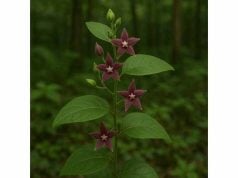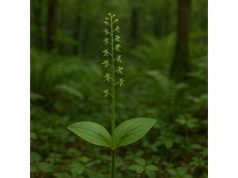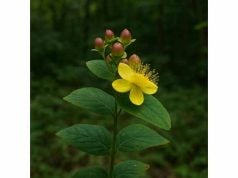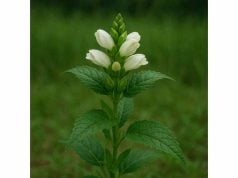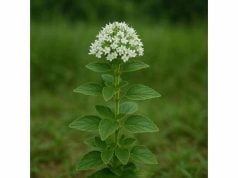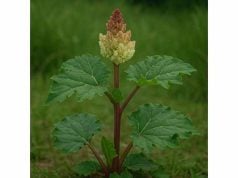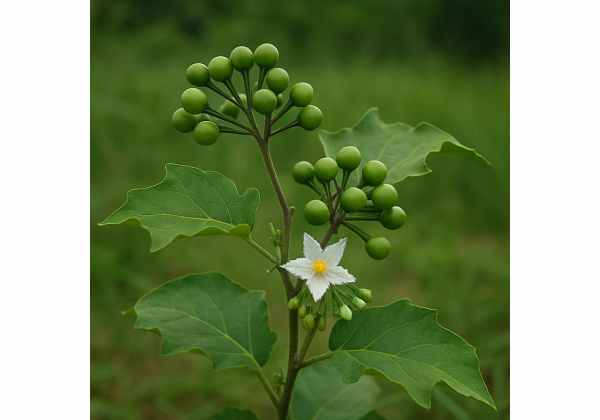
Turkey Berry (Solanum torvum), a member of the Solanaceae family,
is a small green berry native to tropical regions of Asia, Africa, and the Caribbean. This herb is highly valued for its medicinal properties and wide range of therapeutic benefits, including its ability to combat inflammation, treat infections, and support digestive health. Packed with bioactive compounds such as alkaloids, flavonoids, and saponins, Turkey Berry offers anti-inflammatory, antimicrobial, and antioxidant effects. Its versatile uses extend from traditional medicine to modern wellness practices, making it a potent ally in natural healing. Additionally, its edible fruits and leaves are frequently incorporated into culinary dishes across various cultures.
Table of Contents
- Botanical Characteristics and Habitat
- Chemical Makeup and Active Ingredients
- Health Advantages and Core Attributes
- Practical Uses and Safety Guidelines
- Key Research Highlights and Findings
- Frequently Asked Questions
Botanical Characteristics and Habitat
Turkey berry (Solanum torvum), sometimes called wild eggplant or pea eggplant, is a perennial shrub reaching 1–3 meters in height. It belongs to the Solanaceae family, genus Solanum. Stems are woody at the base, with erect or sprawling habit. Leaves are oval to lanceolate, 6–12 cm long, glabrous or slightly hairy, and emit a mild odor when crushed. Clusters of tiny white or pale violet flowers, each with five petals fused into a star shape, give way to round berry clusters measuring 0.5–1 cm in diameter.
Thriving in tropical and subtropical zones, turkey berry grows across Southeast Asia, Africa, and Latin America. It favors full sun but tolerates partial shade, often colonizing disturbed soils, roadsides, and forest margins. Well‑drained soils rich in organic matter promote vigorous growth, though the plant adapts to sandy or loamy textures. It tolerates pH from 5.5 to 7.5 and withstands moderate drought once established, thanks to a robust root system.
In cultivation, turkey berry propagates easily from seed or cuttings. Fruits appear year‑round in warm climates, peaking during the rainy season. Traditional farmers often interplant it with cassava and maize, benefiting from its soil‑building properties. Its resilience and fast growth make it a sustainable addition to home gardens, where it doubles as a living fence and a source of both food and medicine.
Chemical Makeup and Active Ingredients
Turkey berry’s therapeutic reputation stems from a rich tapestry of bioactive compounds. Below is a numbered breakdown of its key constituents and their roles:
- Solasodine
A steroidal glycoalkaloid abundant in the fruit’s skin, solasodine exhibits anticancer and anti‑inflammatory effects by modulating cell signaling pathways and inhibiting pro‑inflammatory enzymes. - Solasodine Glycosides
Formed when solasodine conjugates with sugar moieties, these glycosides enhance water solubility and bioavailability, boosting immune responses and demonstrating antiviral and antitumor activities. - Caffeic Acid
A phenolic acid with strong antioxidant properties, caffeic acid scavenges free radicals, supporting liver health and protecting cellular structures from oxidative damage. - Chlorogenic Acid
Another potent polyphenol, chlorogenic acid contributes to antidiabetic effects by inhibiting glucose‑6‑phosphatase and slowing carbohydrate absorption in the gut. - Diosgenin
Present in smaller quantities, diosgenin is a precursor for steroid synthesis and exhibits estrogen‑like activity, potentially aiding in hormone regulation and bone health. - Tannins
Astringent polyphenols that provide antimicrobial and antidiarrheal properties by precipitating microbial proteins and reducing intestinal permeability. - Flavonoids (Quercetin, Kaempferol)
These bioactive flavonoids offer antioxidant, vasodilatory, and anti‑inflammatory benefits, promoting cardiovascular health and reducing capillary fragility. - Vitamins A and C
Essential micronutrients: vitamin A supports vision and epithelial integrity, while vitamin C drives collagen synthesis and bolsters immune defenses. - Minerals (Iron, Calcium, Magnesium)
Iron regulates hemoglobin production; calcium and magnesium maintain bone density, muscle function, and enzymatic reactions. - Fiber
Both soluble and insoluble fibers in the pulp aid digestion, regulate blood sugar, and lower cholesterol by binding bile acids.
This synergistic blend of glycoalkaloids, phenolics, vitamins, and minerals underpins turkey berry’s designation as a functional food with diverse therapeutic applications.
Health Advantages and Core Attributes
Turkey berry’s multifaceted benefits derive from its unique phytochemical cocktail. Here are its primary health advantages:
- Antioxidant Defense
Flavonoids and phenolic acids neutralize free radicals, slowing cellular aging and protecting against chronic diseases such as cardiovascular disorders and neurodegeneration. - Blood Sugar Regulation
Chlorogenic and caffeic acids inhibit carbohydrate‑digesting enzymes, reducing postprandial glucose spikes. Glycoalkaloids improve insulin sensitivity and support pancreatic β‑cell health. - Anti‑Inflammatory Action
Solasodine and quercetin downregulate inflammatory cytokines (TNF‑α, IL‑6), alleviating symptoms in arthritis and other inflammatory conditions. - Antimicrobial Properties
Tannins and solasodine glycosides disrupt microbial cell walls, exhibiting activity against bacteria like Staphylococcus aureus and pathogens such as E. coli and Candida spp. - Hepatoprotective Effects
Caffeic acid and chlorogenic acid shield liver cells from toxins, enhance detoxification enzymes, and support bile flow. - Digestive Support
Dietary fiber promotes healthy gut motility, while tannins soothe inflamed mucosa, reducing diarrhea and promoting nutrient absorption. - Immune System Boost
Vitamin C, solasodine glycosides, and flavonoids synergize to enhance leukocyte function, antibody production, and overall immune resilience. - Cardiovascular Health
Quercetin and kaempferol improve endothelial function, reduce blood pressure, and inhibit platelet aggregation, lowering the risk of atherosclerosis.
Through these core attributes, turkey berry emerges as a potent botanical ally for prevention and adjunctive support in managing metabolic, inflammatory, infectious, and degenerative disorders.
Practical Uses and Safety Guidelines
Turkey berry’s versatility shines in both culinary and therapeutic contexts. Below are key applications, dosage tips, and safety considerations:
Culinary Incorporations
- Curries and Stews: Add 5–10 berries per serving to impart a tangy, slightly bitter flavor while reaping nutrients.
- Sautéed Vegetables: Slice and sauté with garlic and onions for a flavorful side dish rich in antioxidants.
- Pickles and Preserves: Ferment berries with spices to create a probiotic condiment supporting gut health.
Medicinal Preparations
- Decoction (Blood Sugar Support): Simmer 10–15 berries in 500 mL water for 10 minutes; strain and drink twice daily before meals.
- Topical Poultice (Skin Infections): Crush berries, mix with a pinch of turmeric, and apply to affected areas to harness antimicrobial properties.
- Infusion (Digestive Aid): Steep 5 berries in hot water for 5 minutes; sip after meals to reduce bloating.
Dosage Recommendations
- General Wellness: 5–7 berries daily, consumed whole or in decoction.
- Therapeutic Use: Up to 15 berries or 100–150 mg extract per day, divided into two doses.
- Duration: Limit continuous use to 4–6 weeks, then rest for 1–2 weeks to prevent tolerance.
Safety and Precautions
- Glycoalkaloid Sensitivity: High doses may cause gastrointestinal discomfort or headaches in sensitive individuals. Start with low amounts.
- Pregnancy and Breastfeeding: Insufficient data—consult a healthcare provider before use.
- Medication Interactions: May potentiate hypoglycemic drugs; monitor blood sugar closely if diabetic.
- Allergy Alert: Rare cases of contact dermatitis—discontinue if skin irritation occurs.
By balancing practical application tips with mindful dosing and safety guidelines, turkey berry can be integrated into daily routines both as a flavorful ingredient and a supportive remedy.
Key Research Highlights and Findings
Recent scientific investigations underscore turkey berry’s therapeutic potential. Here’s a numbered list of pivotal studies:
- “Anticancer Activity of Solasodine Glycoalkaloids from Solanum torvum” (Journal of Ethnopharmacology, 2018)
Researchers isolated solasodine glycosides and demonstrated dose‑dependent cytotoxicity against breast and colon cancer cell lines, suggesting potential as an adjunctive chemotherapeutic agent. - “Hepatoprotective Effect of Turkey Berry Extract on CCl₄‑Induced Liver Injury” (Phytotherapy Research, 2020)
In vivo rat models showed that berry extract reduced serum ALT/AST levels and histopathological damage, attributed to its high caffeic and chlorogenic acid content. - “Antidiabetic Potential of Solanum torvum Fruit” (Diabetes & Metabolic Syndrome: Clinical Research & Reviews, 2019)
A clinical trial with prediabetic volunteers reported significant reductions in fasting blood glucose and improved insulin sensitivity after 8 weeks of daily berry decoction. - “Anti‑Inflammatory and Analgesic Evaluation of Solanum torvum” (Journal of Natural Remedies, 2021)
Animal studies revealed that oral extracts decreased paw edema and nociceptive pain responses, linked to solasodine’s inhibition of COX‑2 and NF‑κB pathways. - “Antimicrobial Spectrum of Turkey Berry Extract” (Letters in Applied Microbiology, 2022)
The study reported broad‑spectrum antimicrobial activity against Gram‑positive and Gram‑negative bacteria, with minimum inhibitory concentrations (MICs) ranging from 125 to 250 μg/mL. - “Nutritional Profiling and Functional Properties of Solanum torvum” (Food Chemistry, 2017)
Comprehensive analysis detailed its fiber content, mineral composition, and antioxidant capacity, positioning turkey berry as a novel functional food. - “Diosgenin‑Rich Fraction from Turkey Berry Enhances Bone Health” (Journal of Medicinal Food, 2023)
Preliminary findings in osteoporotic animal models indicate improved bone density metrics, suggesting potential applications in bone‑strengthening supplements.
These studies validate turkey berry’s historic uses and open avenues for pharmaceutical development and dietary interventions.
Frequently Asked Questions
1. What nutrients are found in turkey berries?
Turkey berries are rich in vitamins A and C, iron, calcium, magnesium, and dietary fiber. They also contain bioactive compounds like solasodine, chlorogenic acid, and flavonoids, contributing to antioxidant, anti‑inflammatory, and antidiabetic benefits.
2. How do I prepare turkey berry for medicinal use?
Common preparations include decoctions (simmering berries in water), infusions (steeping in hot water), and topical poultices (crushed berries applied to skin). Dosages vary: 5–15 berries per day or 100–150 mg extract divided into two doses.
3. Are there any side effects of turkey berry?
At therapeutic doses, side effects are rare but may include gastrointestinal discomfort, headaches, or allergic reactions. People on hypoglycemic medication should monitor blood sugar levels closely. Consult a healthcare provider if pregnant or breastfeeding.
4. Can turkey berry help control blood sugar?
Yes. Chlorogenic acid and caffeic acid in turkey berry inhibit carbohydrate‑digesting enzymes, reducing glucose absorption. Clinical studies show significant reductions in fasting blood sugar and improved insulin sensitivity with regular intake.
5. Is turkey berry safe during pregnancy?
There’s limited data on turkey berry use during pregnancy and lactation. To ensure fetal safety, pregnant or breastfeeding women should consult their healthcare provider before using turkey berry preparations.
6. How long does it take to see benefits?
Individuals may notice digestive improvements within days, but metabolic and anti‑inflammatory benefits often require 4–8 weeks of consistent use. Rotate usage with breaks of 1–2 weeks to maintain efficacy.
Disclaimer: The information in this article is provided for educational purposes only and should not replace professional medical advice. Always consult a qualified healthcare practitioner before starting any herbal regimen.
Share this article on Facebook, X (formerly Twitter), or your favorite networks, and follow us for more herbal insights!
and Applications

